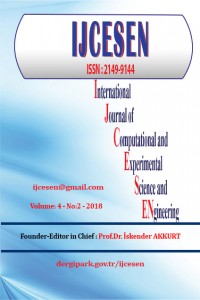Abstract
Temporarily plugging staged fracturing technique has been successfully applied in unconventional reservoirs.Using XFEM-based CZM (cohesive zone model based on the extended finite element method), a 2D capturing stress interference and coupling fluid –solid model was established to investigate the process of the technique. The key points are as follows: (1) The diameter of the whole model was 1000m. The enriched zone is a square with the length of 200 m. The whole model has 162299 nodes and 161901 elements. The quality of meshes meets the requirement of XFEM convergence. (2) plugging efficiency of diverting agents is simulated by changing injection rate. (3) the boundary condition of propped fractures is maintained by surface pressure, change of which simulates filtrate loss rate; (4) heterogeneity along horizontal well is simulated by setting various properties surrounding the subsequent fractures. The simulation results reveal that: (1) in-situ stress contrast affects the extent of the stress alteration zone, while in-situ stress magnitude impacts fracture length and width; (2) proper plugging efficiency will help to achieve even treated effect along the horizontal well; (3) with the augment of formation permeability, the extents of stress reversal and reorientation become small, thus subsequent fractures tend to propagate along the direction of maximum principle stress. (4) Young modulus and tensile strength have a great influence on propagation path, propagation rates, fracture length and width.
Keywords
References
- [1]Zhou, C., Wu, X., Li, H., Ren, Z., & Xin, Y. (2013). Influence of in-situ stress distribution on selection of fracturing fluid backflow technology. Value Engineering, 130(1), 347-351. DOI: 10.12693/APhysPolA.130.347 [2]Weddle, P., Griffin, L., & Pearson, C. M. (2017, January 24). Mining the Bakken: Driving Cluster Efficiency Higher Using Particulate Diverters. Society of Petroleum Engineers. DOI:10.2118/184828-MS [3] Belytschko, T., & Black, T. (1999). Elastic crack growth in finite elements with minimal remeshing. International Journal for Numerical Methods in Engineering, 45(5), 601-620. [4] Dahi Taleghani, A., & Olson, J. E. (2014). How natural fractures could affect hydraulic-fracture geometry. SPE journal, 19(01), 161-171. [5] Fries, T., & Baydoun, M. (2012). Crack propagation with the extended finite element method and a hybrid explicit–implicit crack description. International Journal for Numerical Methods in Engineering, 89(12), 1527-1558. [6] Haddad, M., & Sepehrnoori, K. (2016). XFEM-Based CZM for the Simulation of 3D Multiple-Cluster Hydraulic Fracturing in Quasi-Brittle Shale Formations. Rock Mechanics and Rock Engineering, 49(12), 4731-4748. [7] ÖÖ. Karaçal. (2016). Computational material analysis of structural and hemodynamic model of coronary stent by cfd/fea in computer aided mechanical engineering approach. Acta Physica Polonica, 130(1), 249-251. DOI: 10.12693/APhysPolA.130.249 [8]Y. Özcanli, Çavuş, F. K., & M. Beken. (2016). Comparison of mechanical properties and artificial neural networks modeling of pp/pet blends. Acta Physica Polonica, 130(1), 444-446. DOI: 10.12693/APhysPolA.130.444 [9] Weng, X., Kresse, O., Cohen, C.-E., Wu, R., & Gu, H. (2011, November 1). Modeling of Hydraulic-Fracture-Network Propagation in a Naturally Fractured Formation. Society of Petroleum Engineers. doi:10.2118/140253-PA [10] Wu, R., Kresse, O., Weng, X., Cohen, C.-E., & Gu, H. (2012, January 1). Modeling of Interaction of Hydraulic Fractures in Complex Fracture Networks. Society of Petroleum Engineers. doi:10.2118/152052-MS [11] Shahri, M. P., Huang, J., Smith, C., & Fragachán, F. E. (2017, August 28). Solid-Particulate Diverter Optimization: Coupling Perforation-Scale Particle Transport to Field-Scale Fracturing Simulation. American Rock Mechanics Association.
Abstract
References
- [1]Zhou, C., Wu, X., Li, H., Ren, Z., & Xin, Y. (2013). Influence of in-situ stress distribution on selection of fracturing fluid backflow technology. Value Engineering, 130(1), 347-351. DOI: 10.12693/APhysPolA.130.347 [2]Weddle, P., Griffin, L., & Pearson, C. M. (2017, January 24). Mining the Bakken: Driving Cluster Efficiency Higher Using Particulate Diverters. Society of Petroleum Engineers. DOI:10.2118/184828-MS [3] Belytschko, T., & Black, T. (1999). Elastic crack growth in finite elements with minimal remeshing. International Journal for Numerical Methods in Engineering, 45(5), 601-620. [4] Dahi Taleghani, A., & Olson, J. E. (2014). How natural fractures could affect hydraulic-fracture geometry. SPE journal, 19(01), 161-171. [5] Fries, T., & Baydoun, M. (2012). Crack propagation with the extended finite element method and a hybrid explicit–implicit crack description. International Journal for Numerical Methods in Engineering, 89(12), 1527-1558. [6] Haddad, M., & Sepehrnoori, K. (2016). XFEM-Based CZM for the Simulation of 3D Multiple-Cluster Hydraulic Fracturing in Quasi-Brittle Shale Formations. Rock Mechanics and Rock Engineering, 49(12), 4731-4748. [7] ÖÖ. Karaçal. (2016). Computational material analysis of structural and hemodynamic model of coronary stent by cfd/fea in computer aided mechanical engineering approach. Acta Physica Polonica, 130(1), 249-251. DOI: 10.12693/APhysPolA.130.249 [8]Y. Özcanli, Çavuş, F. K., & M. Beken. (2016). Comparison of mechanical properties and artificial neural networks modeling of pp/pet blends. Acta Physica Polonica, 130(1), 444-446. DOI: 10.12693/APhysPolA.130.444 [9] Weng, X., Kresse, O., Cohen, C.-E., Wu, R., & Gu, H. (2011, November 1). Modeling of Hydraulic-Fracture-Network Propagation in a Naturally Fractured Formation. Society of Petroleum Engineers. doi:10.2118/140253-PA [10] Wu, R., Kresse, O., Weng, X., Cohen, C.-E., & Gu, H. (2012, January 1). Modeling of Interaction of Hydraulic Fractures in Complex Fracture Networks. Society of Petroleum Engineers. doi:10.2118/152052-MS [11] Shahri, M. P., Huang, J., Smith, C., & Fragachán, F. E. (2017, August 28). Solid-Particulate Diverter Optimization: Coupling Perforation-Scale Particle Transport to Field-Scale Fracturing Simulation. American Rock Mechanics Association.
Details
| Journal Section | Research Articles |
|---|---|
| Authors | |
| Publication Date | July 2, 2018 |
| Submission Date | December 15, 2017 |
| Acceptance Date | April 9, 2018 |
| Published in Issue | Year 2018 Volume: 4 Issue: 2 |


